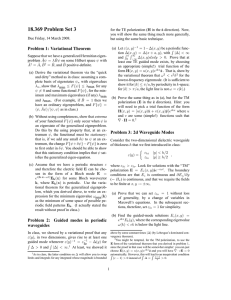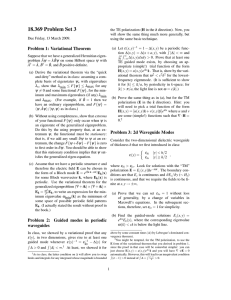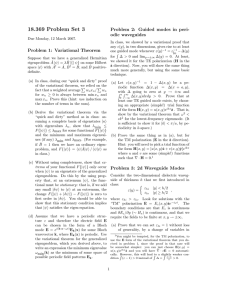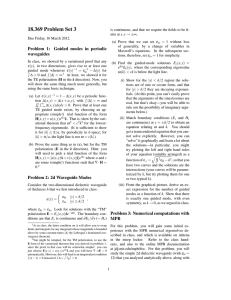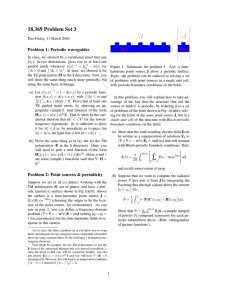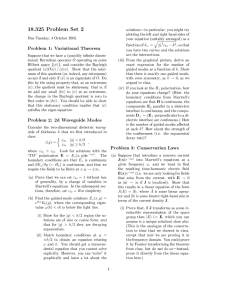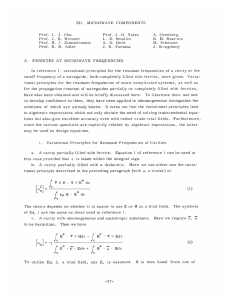18.369 Problem Set 3
advertisement
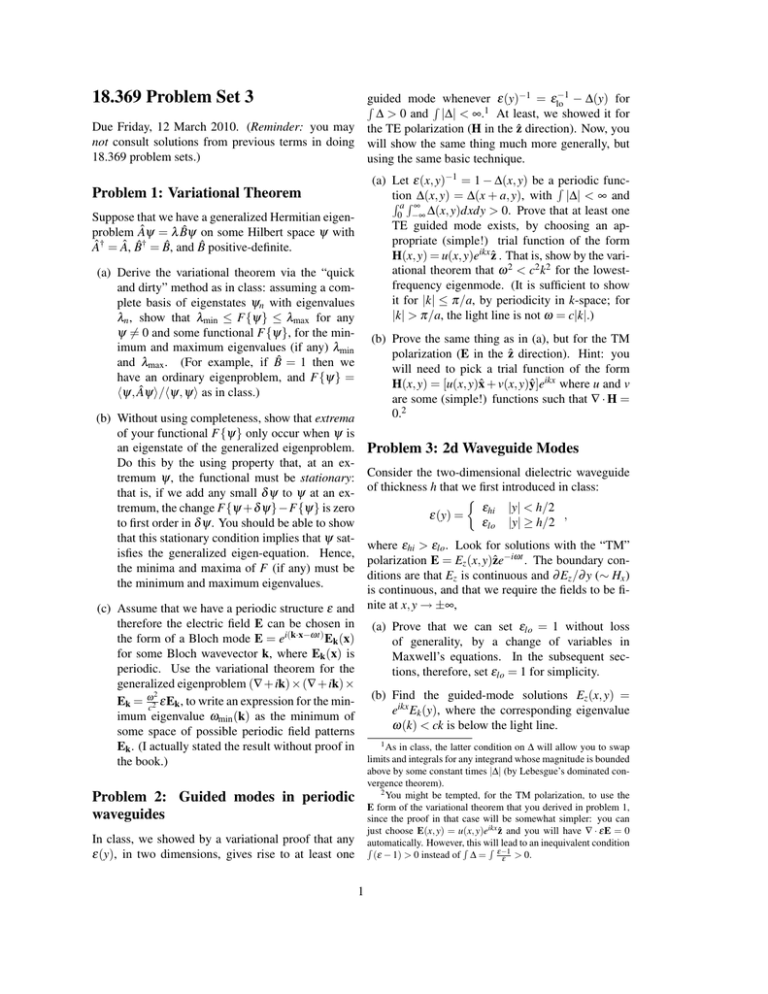
18.369 Problem Set 3
guided modeR whenever ε(y)−1 = εlo−1 − ∆(y) for
∆ > 0 and |∆| < ∞.1 At least, we showed it for
Due Friday, 12 March 2010. (Reminder: you may the TE polarization (H in the ẑ direction). Now, you
not consult solutions from previous terms in doing will show the same thing much more generally, but
18.369 problem sets.)
using the same basic technique.
R
(a) Let ε(x, y)−1 = 1 − ∆(x, y) be a Rperiodic function
∆(x, y) = ∆(x + a, y), with |∆| < ∞ and
RaR∞
0 −∞ ∆(x, y)dxdy > 0. Prove that at least one
TE guided mode exists, by choosing an appropriate (simple!) trial function of the form
H(x, y) = u(x, y)eikx ẑ . That is, show by the variational theorem that ω 2 < c2 k2 for the lowestfrequency eigenmode. (It is sufficient to show
it for |k| ≤ π/a, by periodicity in k-space; for
|k| > π/a, the light line is not ω = c|k|.)
Problem 1: Variational Theorem
Suppose that we have a generalized Hermitian eigenproblem Âψ = λ B̂ψ on some Hilbert space ψ with
† = Â, B̂† = B̂, and B̂ positive-definite.
(a) Derive the variational theorem via the “quick
and dirty” method as in class: assuming a complete basis of eigenstates ψn with eigenvalues
λn , show that λmin ≤ F{ψ} ≤ λmax for any
ψ 6= 0 and some functional F{ψ}, for the minimum and maximum eigenvalues (if any) λmin
and λmax . (For example, if B̂ = 1 then we
have an ordinary eigenproblem, and F{ψ} =
hψ, Âψi/hψ, ψi as in class.)
(b) Prove the same thing as in (a), but for the TM
polarization (E in the ẑ direction). Hint: you
will need to pick a trial function of the form
H(x, y) = [u(x, y)x̂ + v(x, y)ŷ]eikx where u and v
are some (simple!) functions such that ∇ · H =
0.2
(b) Without using completeness, show that extrema
of your functional F{ψ} only occur when ψ is
an eigenstate of the generalized eigenproblem.
Do this by the using property that, at an extremum ψ, the functional must be stationary:
that is, if we add any small δ ψ to ψ at an extremum, the change F{ψ +δ ψ}−F{ψ} is zero
to first order in δ ψ. You should be able to show
that this stationary condition implies that ψ satisfies the generalized eigen-equation. Hence,
the minima and maxima of F (if any) must be
the minimum and maximum eigenvalues.
Problem 3: 2d Waveguide Modes
Consider the two-dimensional dielectric waveguide
of thickness h that we first introduced in class:
εhi |y| < h/2
ε(y) =
,
εlo |y| ≥ h/2
where εhi > εlo . Look for solutions with the “TM”
polarization E = Ez (x, y)ẑe−iωt . The boundary conditions are that Ez is continuous and ∂ Ez /∂ y (∼ Hx )
is continuous, and that we require the fields to be finite at x, y → ±∞,
(c) Assume that we have a periodic structure ε and
therefore the electric field E can be chosen in (a) Prove that we can set εlo = 1 without loss
the form of a Bloch mode E = ei(k·x−ωt) Ek (x)
of generality, by a change of variables in
for some Bloch wavevector k, where Ek (x) is
Maxwell’s equations. In the subsequent secperiodic. Use the variational theorem for the
tions, therefore, set εlo = 1 for simplicity.
generalized eigenproblem (∇ + ik) × (∇ + ik) ×
2
the guided-mode solutions Ez (x, y) =
Ek = ωc2 εEk , to write an expression for the min- (b) Find
ikx E (y), where the corresponding eigenvalue
e
k
imum eigenvalue ωmin (k) as the minimum of
ω(k) < ck is below the light line.
some space of possible periodic field patterns
1
Ek . (I actually stated the result without proof in
As in class, the latter condition on ∆ will allow you to swap
limits and integrals for any integrand whose magnitude is bounded
the book.)
above by some constant times |∆| (by Lebesgue’s dominated convergence theorem).
2 You might be tempted, for the TM polarization, to use the
E form of the variational theorem that you derived in problem 1,
since the proof in that case will be somewhat simpler: you can
just choose E(x, y) = u(x, y)eikx ẑ and you will have ∇ · εE = 0
automatically.
However,Rthis will
R
R lead to an inequivalent condition
(ε − 1) > 0 instead of ∆ = ε−1
ε > 0.
Problem 2: Guided modes in periodic
waveguides
In class, we showed by a variational proof that any
ε(y), in two dimensions, gives rise to at least one
1
(i) Show for the |y| < h/2 region the solutions are of sine or cosine form, and that
for |y| > h/2 they are decaying exponentials. (At this point, you can’t easily prove
that the arguments of the sines/cosines are
real, but that’s okay—you will be able to
rule out the possibility of imaginary arguments below.)
(ii) Match boundary conditions (Ez and Hx
are continuous) at y = ±h/2 to obtain an
equation relating ω and k. You should
get a transcendental equation that you cannot solve explicitly. However, you can
“solve” it graphically and learn a lot about
the solutions—in particular, you might
try plotting the left and right hand sides
of your equationq
(suitably arranged) as a
(b) Plot the fields of some guided modes on a log
scale, and verify that they are indeed exponentially decaying away from the waveguide.
(What happens at the computational cell boundary?)
(c) Modify the structure so that the waveguide has
ε = 2.25 instead of air on the y < −h/2 side.
Show that there is a low-ω cutoff for the TM
guided bands, and find the cutoff frequency.
(There is a general argument that an asymmetric waveguide “cladding” of this sort leads to
low-frequency cutoffs.)
(d) Create the waveguide with the following profile:
2 0 ≤ y < h/2
0.8 − h/2 < y < 0 .
ε(y) =
1 |y| ≥ h/2
function of k⊥ = cω2 2 εhi − k2 , so that you
have two curves and the solutions are the
intersections (your curves will be parameterized by k, but try plotting them for one
or two typical k).
(iii) From the graphical picture, derive an exact expression for the number of guided
modes as a function of k. Show that there
is exactly one guided mode, with even
symmetry, as k → 0, as we argued in class.
Should this waveguide have a guided mode as
k → 0? Show numerical evidence to support
your conclusion (careful: as the mode becomes
less localized you will need to increase the computational cell size).
Problem 4: Numerical computations with
MPB
For this problem, you will gain some initial experience with the MPB numerical eigensolver described in class, and which is available on Athena
in the meep locker. Refer to the class handouts, and also to the online MPB documentation
at jdj.mit.edu/mpb/doc. For this problem, you will
study the simple 2d dielectric waveguide (with εhi =
12) that you analyzed analytically above, along with
some variations thereof—start with the sample MPB
input file (2dwaveguide.ctl) that was introduced in
class and is available on the course web page.
(a) Plot the TM (Ez ) even modes as a function of
k, from k = 0 to a large enough k that you
get at least four modes. Compare where these
modes start being guided (go below the light
line) to your analytical prediction from problem
3. Show what happens to this “crossover point”
when you change the size of the computational
cell.
2
